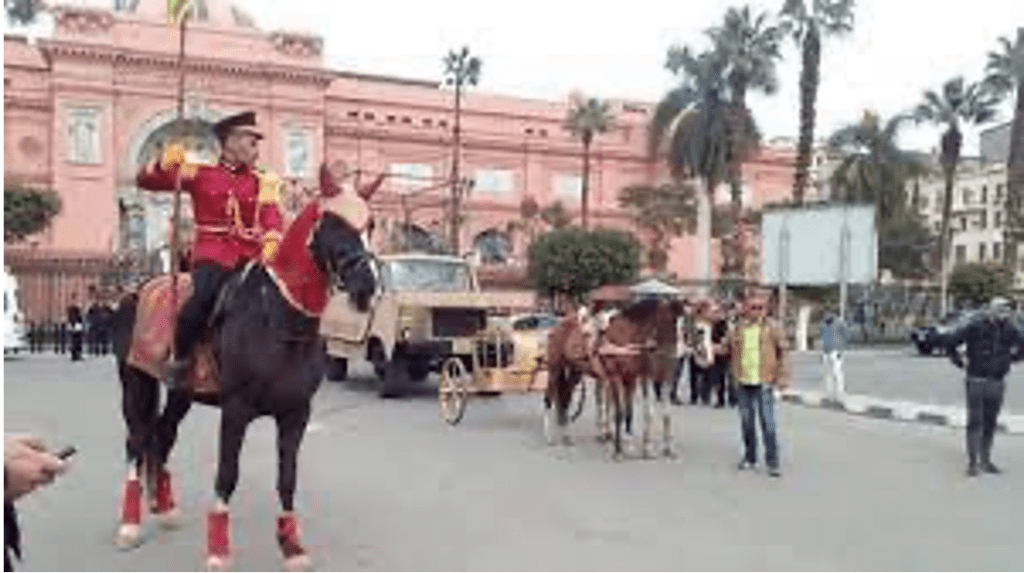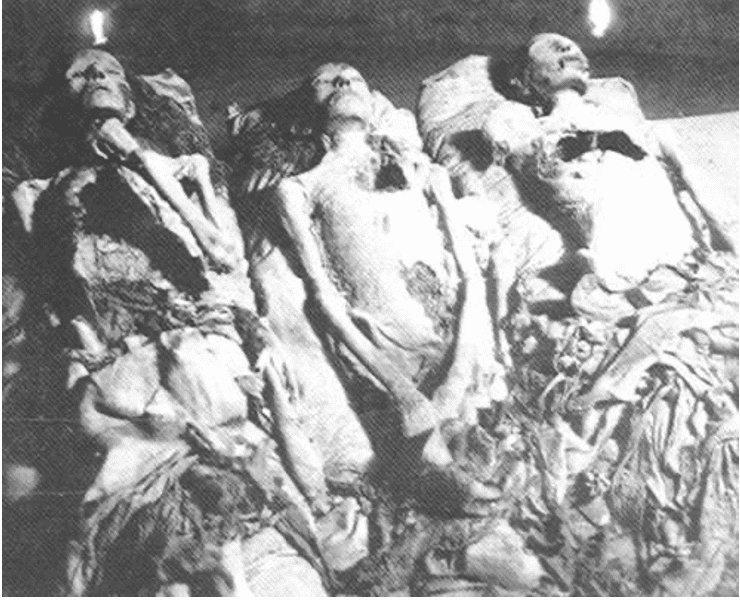The Royal Mummy Parade in Cairo, Broadcast Live Worldwide Saturday April 3, 2021
By Laura Ranieri



You could never come face to face with Henry the VIII.
Never look into the face of Charlemagne, Elizabeth I or Julius Caesar.
But in Egypt, you can actually meet Ramses the Great, Queen Hatshepsut, Seti, Thutmosis III and scores more famous Egyptians… in the flesh (albeit dried out and embalmed flesh).
Some of the less talked about wonders of Ancient Egypt are the amazingly well-preserved bodies of legendary kings and queens that still remain with us after more than 3000 years.
Egypt’s most celebrated royal mummies have resided near Tahrir Square in Cairo for more than a century, in the graceful old pink stone Egyptian Museum. This is all changing – as Egypt undergoes an exciting renaissance in 2021.
On Saturday April 3, 2021 at 5-9pm Cairo time (11-3pm EDT) 22 royal mummies will emerge from the Museum in Tahrir to parade in magnificent vehicles, decorated for royalty, through the streets of Cairo to a brand new museum in Fustat, an old area of Cairo and the very first capital of Islamic Egypt.
Triumphant music, 12-gun salutes and a red carpet of international celebrities will all be part of the festivities.
The “Royal Mummy Parade” will be a magnificent celebration broadcast worldwide. You will be able to watch it live – starting at 11 am EDT (or 5pm Egypt time) with Ancient Egypt Alive on Facebook https://www.facebook.com/ancientegyptalive.
Or on Experience Egypt, Egypt’s Tourism Ministry’s official youtube channel. See preview below.
 The parade will feature 22 mummies, 18 kings and four queens, dating to the17th, 18th, 19th and 20th dynasties (between 1600 and 1100 BCE)… enroute to their new museum home.
The parade will feature 22 mummies, 18 kings and four queens, dating to the17th, 18th, 19th and 20th dynasties (between 1600 and 1100 BCE)… enroute to their new museum home.

Younger lady (KV 35 cache) Ramses II and his father Seti 1 (DB 320 cache)
Procession of the Mummies – 100 plus years after their re-discovery in Luxor
The Saturday procession takes place more than a century after they left Luxor. It begins in Tahrir at the Egyptian Museum and culminates at the splendid new National Museum of Egyptian Civilization (NMEC) in Fustat on the shores of Ayn as Sirah Lake, not far from the hanging church and Ben Ezra synagogue.. The museum, devoted to the civilization of Egypt through the ages, is the second of two great new museums opening in Cairo, the other is the much-anticipated Grand Egyptian Museum on the Giza plateau expected to open by this fall.
Much pomp, and circumstance in store
The mummies will emerge in the early evening and be transferred onto specially built and lavishly decorated individual cars for the procession, each bearing a logo and the name of the royal mummy within, in Arabic, English, as well as hieroglyphs.Seqenenre the war hero and forefather of the 18th dynasty will lead the procession.

The parade will include:
- War chariots and horses accompanying the mummies on both sides of the road.
- a 21 gun salute to honour the pharaohs and announce the commencement of the procession
- A special circular tour around Tahrir Square itself, revolving around the obelisk and Luxor Sphinxes – all lit up for the occasion
- military music, with performances by international celebrities, including Sawsan Badr, Hussein Fahmy, Mona Zaki, and others.
NMEC: restoration at their new home:
Once they arrive at NMEC, the mummies will undergo a 15-day restoration in a laboratory before they take up their new residence in lavish new showcases at the Royal Mummies Hall. This hall, with stark black walls, is designed to replicate the “Valley of the Kings,” – and will also include lots of enriched information for visitors on the individual kings, their reigns, their CT scan results, and the mummification process.

The royal mummies include these luminaries of Egyptian history:
- King Ramses II – or Ramses the Great: The most powerful and celebrated King of Egypt: (c. 1303-1213 BCE)
Interestingly, Ramses is our best travelled Royal Mummy. In 1976, the ginger-haired king who lived to his 90s, travelled to France for special preservation treatment with French forensic specialists. They paraded him through the streets of Paris with great fanfare when he arrived – with his own passport in (withered) hand!

- King Seqenenre Tao c. 1560 to 1555 BCE (reign)
The oldest of the mummies and the forefather of the New Kingdom, we know Seqenenre as a brave 17th dynasty king who was likely executed in battle. His head bears seven wounds of a Hyksos battle axe.

- Seti I (1373-1279 BCE)
Arguably the most beautifully preserved mummy of them all, Seti was the father of King Ramses the Great – and also a great and powerful king in his own right. His “Seti as Osiris” Temple in Abydos is among the most exquisite in Egypt. Isn’t he handsome?

- Queen Hatshepsut (c. 1507-1458 BCE)
This remarkable lady ruled Egypt early in the 18th dynasty assuming all the regalia and titles of a king. Her legacy: an abundance of stunning monuments and temples to her beloved father, the god Amun. Her journey to Punt (in present day Somalia) via the Red Sea to trade iron ingots and wheat for precious oils, exotic beasts and incense trees is legendary. Her overweight mummy was “rediscovered” by Donald Ryan in KV 60 (originally by Carter in 1903) – and identified to be the controversial Queen on the basis of a tooth matched to the mummy (2007).

Stowed away for millennia by high priest of Pinudjem II c. 1000 BCE
During the decline of Egypt (after the New Kingdom) when tombs were being looted, a good-hearted priest stowed away the Royal mummies in secret caches. The larger of the mummy cache– TT320 – was rediscovered in 1881 by Antiquities Minister Gaston Maspero in 1881 in the hills of Western Thebes above Hatshepsut’s mortuary temple. 12 of the mummies in the parade are from this cache, The 50 plus mummies originally discovered by Maspero were in a sad array and enclosed in random coffins that did not belong to them. Another cache of 13 mummies was found by Victor Loret in 1898 in the Valley of the Kings, hidden deep within the tomb of Amenhotep II KV35, including Ramses III, Siptah, Amenhotep III and his Queen Tiye, also in sad condition. 10 of the mummies in the procession are from this second cache.
The priest in question who saved the mummies was Pinudjem II. We know this from an inscription on the bandage of Ramses II’s mummy:
“Year 15, 3rd month of Akhet, Day 6: Day of bringing the Osiris king Usermaatre-setepenre (Ramesses II), Life! Prosperity! And Health!, to renew him and to bury him in the tomb of the Osiris king Menmaatre-Seti (I) Life! Prosperity! Health! By the high priest of Pinudjem.”
It was said that when these two caches of mummies down the Nile from Luxor to Cairo in the late 19th century, visitor lined the shore, wailing and lamenting, as they were losing their beloved kings, taken from the Valley.
They arrived in Cairo before the Egyptian Museum in Tahrir (1903) was completed. The Mummy’s first home was at the Boulaq Museum, pictured below


Left to right Queen Tiye (elder lady) , Amarna prince and younger lady (Tutankhamun’s mother), as found by Loret in 1898 Mummy Cache KV35
Watch it with Ancient Egypt Alive
Again, you can watch the parade at our facebook page with Canadian colour commentary 11am-3pm EDT on Saturday April 3.
https://www.facebook.com/ancientegyptalive
or on the Experience Egypt youtube page, Saturday commencing 11EDT.
We can all wait with baited breath for our opportunity to visit these legends in their new forever home – as well as to experience in person..all the magnificent new museum(s) and sites set to open this year in Cairo and across Egypt.
###
